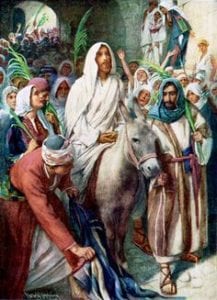
Catechism Lesson 14: The Life of Jesus Christ (Part 3)
The Journey to Jerusalem
The Galilean ministry of Christ ended with His departure for Jerusalem. Luke’s Gospel tells us the beginning of Jesus’ journey to Jerusalem: “When the days for His being taken up were fulfilled, He resolutely determined to journey to Jerusalem. (Luke 9:51)” The “days for His being taken up” refers to the “exodus” which Jesus was to accomplish in Jerusalem (cf. Luke 9:31); i.e., His suffering, death, resurrection and ascension. There are two things to note between Jesus’ Galilean ministry and His entry to Jerusalem: (1) The Baptism of Christ marked the transition to Jesus’ ministry in Galilee, whereas the Transfiguration marked the transition to Jesus’ journey to Jerusalem. In both events, a voice was heard from heaven, saying: “This is my beloved Son with whom I am well pleased. (Matthew 3:17, 17:5)” (2) Just as the Galilean ministry began with a rejection of Jesus in His hometown, so too, did the journey to Jerusalem begin with the rejection of Jesus by a Samaritan village.
If we are to follow the Gospel of Luke, many things happened during Jesus’ journey to Jerusalem: (1) Jesus sent seventy disciples ahead of Him, into every town and place where He Himself was about to go (10:1); Jesus visited Martha and Mary (10:38-42). (2) Jesus taught many parables – the Good Samaritan (10:25-37), the Rich Fool (12:13-21), the Unfaithful Servant (12:41-48), the Fig Tree (13:6-9), the Mustard Seed and the Leaven (13:18-21), the Great Banquet (14:15-24), the Lost Sheep and the Lost Coin (15:1-10), the Prodigal Son (15:11-32), the Dishonest Steward (16:1-13), the Rich Man and Lazarus (16:19-31), the Persistent Widow (18:1-8), the Pharisee and the Tax Collector (18:9-14), the Talents (19:11-27). (3) Jesus performed many miracles – healing the crippled woman (13:10-17), the man with dropsy (14:1-6), ten lepers (17:11-19), the blind man near Jericho (18:35-43). (4) Jesus taught His disciples the Lord’s Prayer (11:1-4), perseverance in prayer (11:5-13), against hypocrisy (12:1-3), whom to fear (12:4-12), against anxiety (12:22-34), to be watchful (12:35-40), humility (14:7-14), discipleship (14:25-33), the coming of the Kingdom (17:20-37).
The Entry into Jerusalem
Jesus entered Jerusalem in a manner that fulfilled the prophecy of Zechariah: “Exult greatly, O daughter Zion! Shout for joy, O daughter Jerusalem! Behold: your king is coming to you, a just savior is he, humble, and riding on a donkey, on a colt, the foal of a donkey. (Zechariah 9:9)” The crowds that went before Him shouted: “Hosanna to the Son of David! Blessed is He who comes in the name of the Lord! Hosanna in the highest! (Matthew 21:9)”
Jesus’ entry into Jerusalem manifested the coming of the Kingdom that the King-Messiah was going to accomplish by the Passover of His Death and Resurrection. (CCC 560)
While in Jerusalem, Jesus drove out from the temple those who have turned His Father’s house into a marketplace (Mark 11:15-19, Luke 19:45-48). Jesus also had several encounters with the scribes and the Pharisees, and Jesus denounced their hypocrisy (Matthew 23:1-36, Mark 12:38-40, Luke 20:45-47). Jesus foretold the destruction of the Temple (Matthew 24:1-2, Mark 13:1-2, Luke 21:5-9), and the destruction of Jerusalem itself (Luke 21:20-24). At this point in time, the chief priests and the scribes were seeking how to put Jesus to death (Matthew 26:1-5, Mark 14:1-2, Luke 22:1-2).
Questions:
- When did the Galilean ministry of Christ end?
- Name three parables which Jesus taught on His way to Jerusalem.
- Name three miracles which Jesus performed on His way to Jerusalem.
- Name three things which Jesus taught His disciples on His way to Jerusalem.
- True or False. Jesus went to Jerusalem to be crowned King of Israel.
- True or False. Jesus’ entry into Jerusalem fulfilled the prophecy of Zechariah.
- What did Jesus say when He drove out the moneychangers from the Temple in Jerusalem? (see Mark 11:17)
- Name the people who wanted to put Jesus to death.